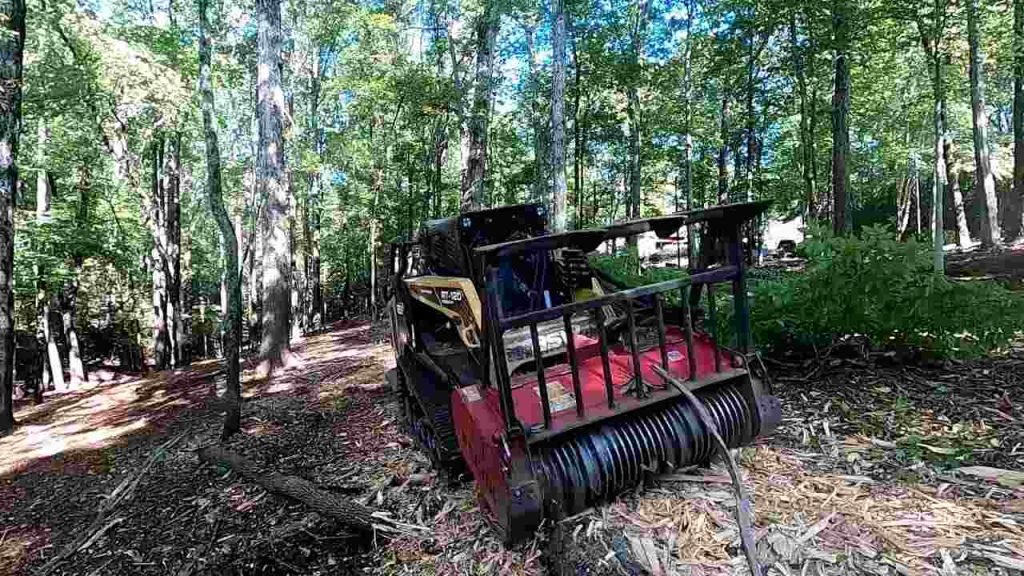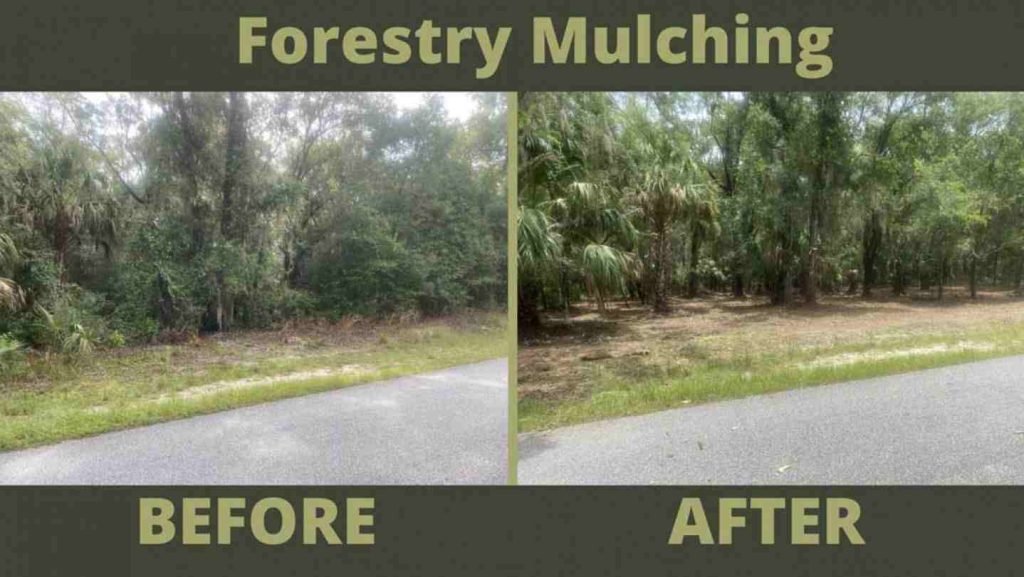Forest mulching and burning are two methods used in land management, each with distinct environmental impacts. Forest mulching involves using machinery like forestry mulchers to grind vegetation and organic matter into mulch. In this comprehensive article, Rightway Forestry helps to unravel some environmental advantages over burning. First, mulching retains organic matter in the soil, enhancing soil fertility and moisture retention. Second, it reduces air pollution by eliminating the smoke and particulate matter produced during burning. Third, mulching helps prevent erosion by maintaining vegetation cover. Overall, forest mulching is a sustainable land management practice that promotes soil health, reduces air pollution, and preserves ecosystem stability compared to the environmental risks associated with burning.
Preserving Soil Fertility
Forest mulching and burning represent two distinct approaches to vegetation management, each with its environmental implications. One notable advantage of forest mulching over burning is its ability to preserve soil fertility. When organic matter from vegetation is mulched and left to decompose, it enriches the soil with essential nutrients, such as nitrogen, phosphorus, and potassium. This process enhances soil fertility, promoting healthier plant growth and ecosystem resilience. In contrast, burning vegetation removes organic matter from the soil, leading to nutrient depletion and reduced fertility. Over time, this can degrade soil quality, making it less suitable for supporting diverse plant and microbial communities. By choosing mulching over burning, land managers can help maintain soil fertility and sustain the long-term productivity of forest ecosystems.
Mitigating Air Pollution

Another significant environmental advantage of forest mulching is its ability to mitigate air pollution compared to burning. When vegetation is burned, it releases various pollutants into the atmosphere, including carbon dioxide, carbon monoxide, and particulate matter. These pollutants contribute to air pollution, degrade air quality, and pose health risks to humans and wildlife. In contrast, mulching avoids the release of pollutants by allowing organic matter to decompose naturally. This reduces the emission of harmful gases and particles, helping to maintain cleaner air and healthier environments. By prioritizing mulching over burning, forest managers can minimize the negative impacts of air pollution on both local and regional scales, supporting public health and environmental well-being.
Conserving Biodiversity
Forest mulching plays a crucial role in conserving biodiversity by preserving habitats and ecosystems within forested areas. Unlike burning, which can destroy vegetation and disrupt wildlife habitats, mulching retains organic matter on the forest floor, providing essential resources for diverse plant and animal species. Mulch acts as a natural mulch that regulates soil moisture, temperature, and nutrient levels, creating favorable conditions for plant growth and habitat formation. This, in turn, supports a wide range of wildlife, including insects, birds, mammals, and microorganisms. By maintaining biodiversity through mulching practices, land managers can help protect endangered species, promote ecosystem resilience, and sustain healthy forest ecosystems for future generations.
Preventing Soil Erosion
Soil erosion is a significant environmental concern that can result from vegetation management practices such as burning. When vegetation is burned, it removes protective cover from the soil, making it more susceptible to erosion by wind and water. This can lead to soil degradation, loss of fertile topsoil, and increased sedimentation in nearby water bodies. In contrast, forest mulching helps prevent soil erosion by retaining organic matter on the forest floor, creating a natural barrier against erosion processes. Mulch acts as a protective layer that reduces water runoff, minimizes soil compaction, and enhances soil structure and stability. By preventing soil erosion through mulching, land managers can preserve soil productivity, protect water quality, and maintain the integrity of forest ecosystems.
Enhancing Carbon Sequestration

Forest mulching contributes to carbon sequestration, which plays a crucial role in mitigating climate change by removing carbon dioxide from the atmosphere and storing it in vegetation and soil. When organic matter from mulched vegetation decomposes, it releases carbon into the soil, where it can be stored for long periods. This helps offset carbon emissions from human activities, reducing the concentration of greenhouse gases in the atmosphere and mitigating global warming. In contrast, burning vegetation releases carbon stored in plants back into the atmosphere, contributing to carbon emissions and exacerbating climate change. By prioritizing mulching over burning, land managers can enhance carbon sequestration, support climate resilience, and contribute to global efforts to combat climate change.
Reducing Wildfire Risk
Forest mulching can help reduce the risk of wildfires by removing dead vegetation and creating firebreaks that limit the spread of fires. By clearing flammable materials from the forest floor, mulching reduces the fuel available for wildfires, making it easier to control and contain them. This can help protect both natural ecosystems and human communities from the devastating impacts of wildfires, including loss of life, property damage, and environmental destruction. In contrast, burning vegetation can sometimes lead to uncontrolled wildfires if not managed properly, posing significant risks to public safety and ecosystem health. By implementing mulching practices as part of wildfire prevention strategies, land managers can reduce the likelihood and severity of wildfires, promoting safer and more resilient forest ecosystems.
Energy Efficiency and Resource Conservation
Forest mulching offers energy efficiency and resource conservation benefits compared to burning practices. Mulching machinery utilizes less energy and resources than burning operations, reducing overall carbon footprint and environmental impact. Furthermore, mulching retains organic matter within the ecosystem, preserving valuable nutrients and biomass that can be recycled back into the soil.
In contrast, burning vegetation consumes significant amounts of fuel and emits pollutants, contributing to energy inefficiency and resource depletion. The combustion of organic material leads to the loss of nutrients and biomass, diminishing the natural fertility and productivity of forest ecosystems. Emphasizing mulching techniques promotes sustainable resource management and minimizes waste in forestry operations.
Habitat Restoration and Regeneration
Forest mulching supports habitat restoration and regeneration efforts by creating conducive environments for native species recovery. Mulched areas provide shelter, food sources, and breeding grounds for wildlife, contributing to the restoration of degraded habitats. The gradual decomposition of mulch enriches the soil, facilitating the growth of diverse plant communities and enhancing overall ecosystem resilience.
In contrast, burning can hinder habitat restoration by destroying vegetation and disrupting ecological processes. Intense fires can alter soil properties, hinder seed germination, and impede natural regeneration processes. By prioritizing mulching as a restoration tool, land managers can accelerate ecosystem recovery and promote the return of native species.
Community Health and Well-being
Forest mulching positively impacts community health and well-being by reducing exposure to smoke, air pollutants, and wildfire risks. Mulching operations generate minimal smoke and emissions compared to burning, leading to improved air quality and respiratory health for nearby communities. Additionally, mulched areas act as firebreaks, protecting homes and infrastructure from wildfire threats.
In contrast, burning practices contribute to air pollution, haze, and respiratory illnesses, especially in areas with vulnerable populations. Smoke from forest fires can travel long distances, affecting air quality in urban and rural areas alike. Emphasizing mulching techniques prioritizes public health and safety while minimizing the negative impacts of forest management activities.
Economic Opportunities and Job Creation
Forest mulching creates economic opportunities and supports job creation in forestry and land management sectors. Mulching operations require skilled labor, machinery maintenance, and logistical support, leading to job growth and economic stimulation in rural communities. Furthermore, mulch production can generate revenue through the sale of organic materials for landscaping, erosion control, and agricultural applications.
In contrast, burning practices may result in limited economic benefits and negative externalities such as firefighting costs, air pollution-related healthcare expenses, and property damage. Adopting mulching as a sustainable land management practice contributes to local economies, fosters entrepreneurship, and promotes a more diverse and resilient forestry sector.
Water Quality Protection
Forest mulching contributes to water quality protection by reducing sedimentation and nutrient runoff into streams, rivers, and lakes. The mulch layer acts as a natural filter that traps sediment and pollutants, preventing them from entering water bodies and affecting aquatic ecosystems. This protection extends to drinking water sources, ensuring clean and sustainable water supplies for communities.
In contrast, burning practices can lead to ash and debris runoff, contaminating water sources and impairing water quality. Ash from fires may contain harmful chemicals and heavy metals that pose risks to aquatic life and human health. By prioritizing mulching techniques, land managers can safeguard water resources and support aquatic biodiversity.
Long-Term Forest Resilience
Forest mulching promotes long-term forest resilience by enhancing ecosystem functions and adaptive capacity. Mulched areas experience improved soil fertility, increased moisture retention, and enhanced biodiversity, making them more resilient to climate variability and environmental stresses. Healthy forests with diverse vegetation cover are better equipped to withstand disturbances and recover from natural events such as droughts and storms.
In contrast, repeated burning can degrade forest ecosystems and compromise their ability to recover from disturbances. Burned areas may experience soil degradation, reduced water-holding capacity, and increased vulnerability to invasive species. By adopting mulching as a sustainable land management practice, forest managers can promote resilience and ensure the long-term health of forested landscapes.
Conclusion:
In conclusion, forest mulching offers significant environmental advantages over burning. It promotes soil health, reduces air pollution, and helps prevent erosion, making it a more sustainable land management option. By retaining organic matter in the soil, mulching contributes to soil fertility and moisture retention, supporting healthy ecosystems. Additionally, the elimination of smoke and particulate matter during mulching reduces air pollution and its associated health risks. The preservation of vegetation cover also plays a crucial role in preventing erosion and maintaining ecosystem stability. Overall, choosing forest mulching over burning aligns with sustainable land management practices and contributes positively to environmental conservation efforts.

